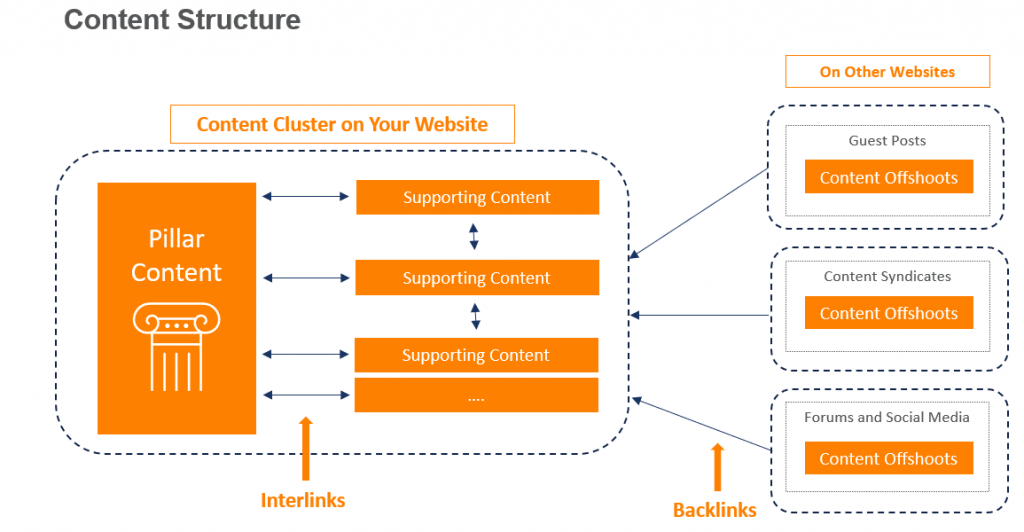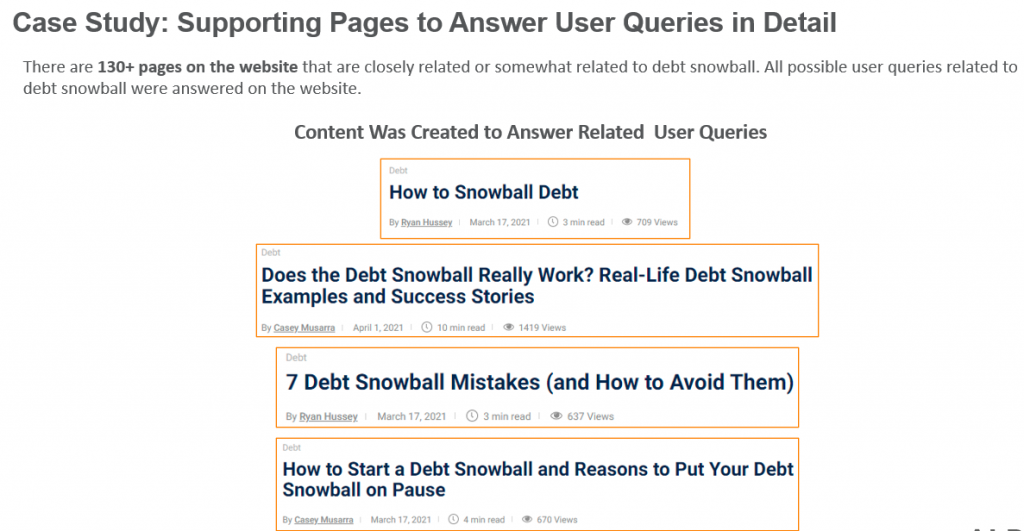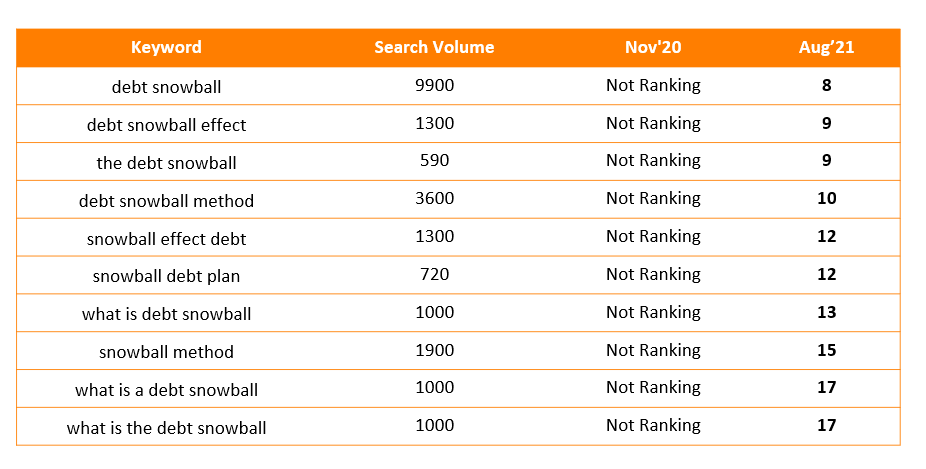As an SEO practitioner, you would have heard “EAT” countless times. However, despite all that, there are still some rumors around it on how you can improve your website’s E-A-T score.
In this post, we’ll discuss in detail the significance of E-A-T in Google ranking and the three most important contributing factors to improve your Google E-A-T score.
How a good structure with a High E-A-T Score looks like
The content structure is the first thing to look at if you would like to improve your EAT scores. Why? Because this is something that you need to look at strategically.
Here’s an example of how we improved our EAT scores for the target keyword “Debt Snowball.” We have created multiple content on the topic, then tightly interlinking it to other long-tail keywords related to “Debt snowball.”
We have tried comprehensively capturing the topic and then interlinking it back to the core topic.
Post this, we received multiple backlinks from several reputable sources in the same niche.

Here are a few key contributing factors for EAT scores

Content Depth and Diversity
Back in 1996, Bill Gates said “Content is the King”.
But we’re not debating whether your site needs great content or not — it does without a question.
The question we want to focus on here is whether content quality impacts ranking through E-A-T.
As per Google’s Search quality rater guidelines(SQRG), there’s more to a good piece of content than keyword density and behavioral signals.
Here’s what should a good page look like, according to the Google SQRG.
“For informational content: very high-quality MC is original, accurate, comprehensive, clearly communicated, professionally presented, and should reflect expert consensus as appropriate. Expectations for different types of information may vary. For example, scientific papers have a different set of standards than information about a hobby such as stamp collecting. However, all types of very high-quality informational content share common attributes of accuracy, comprehensiveness, and clear communication, in addition to meeting standards appropriate to the topic or field.”
According to our experience, Google checks whether a page’s content is accurate, comprehensive, and clearly communicated. Therefore, you must ensure that your content is all of the above.
So, how to create your content structure to build High E-A-T?
Here are a few steps you can follow:
Step 1: A Comprehensive Topic Research
Today, just doing keyword research is not enough for E-A-T! To win in E-A-T, you need comprehensive research to figure out all the queries that a user might have on your chosen topic.
Right from when a user faces a problem that eventually leads them to start looking for a solution, comparing different solutions, during purchase, and post purchase service level queries.
You must have the answer to all the queries a user might have across the entire buyer journey on your website or your blogs.
To do this in a structured way, first, you need to create a list of:
- Semantically Relevant Subtopics
- User’s Questions Around the Topic
- Important Phrases Related to the Topic
- Competitor Topic choices
At the end of this step, you’ll have a comprehensive list of related topics, subtopics, phrases, visual elements, etc., ready for your content.
However, this can be time-taking. Therefore, you can leverage a modern SEO tool to speed up the research process and produce better results in less time.

Step 2: A Content Structure
Today, most enterprises that have started ranking for a topic in a short time generally follow a Pillar and supporting page structure. Now, what is exactly a pillar page?
Let’s understand that first.
So, what is a pillar page?
A pillar page is the foundation of any topic cluster to be built. It covers all elements in and around a topic on a single page, with space for more in-depth reporting in detailed cluster blog posts that link back to the actual pillar page.
Pillar pages cover a particular topic extensively, and all cluster contentshould address a particular keyword linked to that topic in-depth.
For instance, you might write a pillar page about Search engine optimization (SEO) — a broad topic –and one of the cluster contents should be about Topical Authority — a more precise keyword within the SEO topic.
Content on the Pillar pages is lengthier than our regular blog posts — as they cover every facet in and around a topic you’re aiming to rank for — but they aren’t as detailed.
That’s exactly what cluster content is for. You would want to build a pillar page that answers all user queries around a specific topic but leaves space for more details in the following related cluster content.
Creating an extensive linking between the pillar content and the subsequent supporting content is also essential so that the user doesn’t have to go outside your website for any answer around your topic.
For this entire cluster of content, you have on your website, you have to create content offshoots that are systematically posted on some reputed websites outside your own website to get outside validation. This approach helps you in:
- Improving your reader base
- Getting outside validation
- Building authority

Pillar Page: What to Plan For?
When a user searches for something on the internet, mostly their queries don’t give any idea of their real intent.
For example: If a user types “Credit Card” on the search engine, we don’t know what exactly they are looking for. Whether they want to know the eligibility to apply for credit cards, compare different credit cards, or apply for a credit card.
However, the term “Credit Card” on the entire credit card subject is a broad term with the highest search volume.
Therefore, it’s natural that many people would be vying to rank for this specific term. To rank for this term, you need to follow the guidelines of Google EAT.
In EAT guidelines, Google says that to create High Quality Content, you need to:
- Address all user needs and intents around a topic
- Reflect time and effort given in creating that content
- Authenticity
Therefore, to create an effective pillar page, there is a 3-way framework you can use.

Example Case Study for Pillar Page for Credello.com
Here, you’ll find a perfect example of how a Pillar Page can be structured to drive maximum gains from Google EAT.

Step 3: Create Supporting Pages
Now that we have our pillar page, we need to shift our focus to creating the supporting pages which will answer the other related queries.
Any supporting topic that requires a detailed answer or going into depth must have a dedicated page on your domain.
The Inverted Pyramid Information Architecture works best for creating the supporting pages. Here are a few things to follow while creating your supporting pages:
- The first thing is to answer the most important questions like who, what, when, etc.
- Then substantiate the answers with relevant Data Points
- Finally, all general background information

Example Case Study for Supporting Pages
In this example you’ll see how Supporting Pages can be structured to drive maximum gains from Google EAT.

Step 4: Content Offshoots
When you have your pillar and supporting content ready, you’d like to have that outside validation for your content through Content Syndication, Guest posts, and posting on Forums.

Example of Content Offshoots for ‘Debt Snowball’ from Credello.com

Final Content Structure Example: Debt Snowball from Credello.com
With all the above steps completed, here is the structure that you should aim for to excel in Google E-A-T.

Using Interlinks to strengthen the structure
What is Interlinking?
Internal linking is the SEO process of adding hyperlinks from one page to another page on your website. Internal links point to various website pages and help search engines and users as they build a hierarchy of significance for your web pages, enhance your website’s navigation, and add context to your content. With this, internal links help improve your web page’s visibility and relevance.
How does Interlinking help?
Internal linking enables Google to locate, index, and understand all the web pages on your website. It helps you build page authority for your strategic pages.
It is the key for any website that wants to drive organic rank and traffic improvements.
Interlinking is helpful for three primary reasons:
- They enable users to navigate a website easily.
- They help showcase an information hierarchy for any given website.
- They enable spreading link equity (ranking power) around websites.

Example Case Study: Tight Interlinking of Content Cluster

In the above example of Debt Snowball interlinking, you’ll see the words marked in green are the links going to the related webpages.
They help users navigate to supporting web pages when they want to gather more in-depth information on that supporting topic. It ensures a coherent user experience.
Building External Links to Improve Authority
When you have a solid content structure and tightly interlinked supporting pages, you need to build authority and get outside validation on whether the content is of high quality.
We can do this by using various Link Building strategies like:
Partnerships
Link Building through partnerships is like teaming up with reputed brands and websites with a similar audience to gain natural backlinks to your web pages.
Content Syndication
Syndicating your content for link building is a way you can republish your content on one or more third-party websites. These third-party websites post your content without any further edits or changes but backlinking to you on the post, validating your authorship.
Guest Posts
Guest posting is an approach marketers use to publish their content as guest bloggers to a third-party website with high domain authority. With this, you can get access to a new audience and acquire natural links to your own website.
Posting on Social and Forums
Link building through social media and forum posting is one of the top methods used by marketers. Various social media or forums can be a great way to interact, share information, discuss products and discover new interests.
Though forum backlinks are one of the best link-building strategies, you won’t find too many people using them because they are the most challenging links to acquire.
But with the right strategy, you can ensure that you acquire more natural links and build brand awareness through social media and forum posting.

Link Building Case Study Example for “Debt Snowball”

Link Building mistakes to avoid
For example, when you release a press release, there is a high chance that your content is picked up by some spammy publishers as well. It would send a negative signal to Google about your website, which can severely hurt your reputation. To avoid this, you can use strategies like:
- Disavowing spammy links
- Proper distribution of Do-Follow and No-Follow links
- Correct distribution of Anchor Texts

Case Study Results: Debt Snowball
Here is the final view of the results for ‘Debt Snowball” from Credello.com. Being in the YMYL sector, you can still see a huge improvement in rank for a highly competitive keyword within just 9 months following Google’s E-A-T guidelines (image below). Though Credello is still not ranking on Page 1, with more concentrated effort, they can achieve that soon.
Our learning from this entire Debt Snowball Case Study is that you can win in any competitive space with a coherent content and link strategy.

Conclusion
Following Google’s E-A-T guidelines as a framework when working on your brand’s organic marketing indicates you’re taking a comprehensive approach to SEO and organic content marketing.
Covering these three pillars of content, internal links, and backlink building is an intelligent thing to do, especially when you want your pages to rank on Google for the best search terms in your niche.
However, doing all this manually can be an effort-intensive exercise with a lot of manual effort.
Instead, you can leverage modern SEO tools available in the market. ALPS.ai is one such tool with features to help you win in Google’s E-A-T. How? It allows you to:
- Do in-depth and exhaustive topic research
- Score to measure and benchmark the Topical Authority
- Monitor your content, links, and ranks
- Get health status for all your links in terms of critical, warning, and healthy
- Create automated, well-researched, and comprehensive Content Briefs to create high-quality organic content
If you want to know more about how to improve your organic performance by following Google E-A-T guidelines, sign up for a free demo here!






